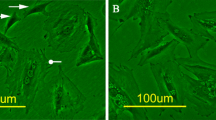Summary
Two cell types, one epithelioid and the other fibroblast-like, were found in human testicular cultures derived from testes of patients. Ultrastructural studies indicated that, whereas the epithelioid cells were Sertoli cells, the fibroblast-like cells were fibroblasts. The Sertoli cells could maintain growth for a period of more than 4 months. In cultures derived from normal testes, only fibroblasts were observed.
Similar content being viewed by others
References
Leblond, C. P., and Y. Clermont. 1952. Definition of the stages of the cycle of the seminiferous epithelium in the rat. Ann. N. Y. Acad. Sci. 55: 548–570.
Chen, A. T. L., J. A. Reidy, Y. S. Fu, and W. W. Koontz. 1974. Human testicular cultures. I. Chromosome analyses. Proc. Soc. Exp. Biol. Med. 146: 442–447.
Kodani, M., and K. Kondani. 1966. The in vitro cultivation of mammalian Sertoli cells. Proc. Natl. Acad. Sci. U.S.A. 56: 1200–1206.
Jordan, R. T., S. Katsh, and N. Stackelburg. 1961. Spermatocytogenesis with possible spermiogenesis of guinea pig testicular cells grownin vitro. Nature 192: 1053–1055.
Ellingson, D. J., and K. T. S. Yao. 1970. Growth and observations of Chinese hamster seminiferous epitheliumin vitro. J. Cell Sci. 6: 195–205.
Steinberger, A., and E. Steinberger. 1966.In vitro culture of rat testicular cells. Exp. Cell Res. 44: 443–452.
Ferris, R. D., and W. Plowright. 1958. Simplified method for the production of monolayers of testis cells from domestic animals and for the serial examination of monolayer cultures. J. Pathol. Bacteriol. 75: 313–318.
Hess, W. R., H. J. May, and R. E. Patty. 1963. Serial cultures of lamb testicular cells and their use in virus studies. Am. J. Vet. Res. 24: 59–64.
Steinberger, A., and E. Steinberger. 1970. Tissue culture of male mammalian gonads. In Vitro 5: 17–27.
Vilar, O., A. Steinberger, and E. Steinberger. 1967. An electron microscopic study of cultured rat testicular fragments. Z. Zellforsch. Mikrosk. Anat. 78: 221–233.
Vilar, O., A. Steinberger, and E. Steinberger. 1966. Electron microscopy of isolated rat testicular cells grown in vitro. Z. Zellforsch. Mikrosk. Anat. 74: 529–538.
Bawa, S. R. 1963. Fine structure of the Sertoli cell of the human testis. J. Ultrastruct. Res. 9: 459–474.
Brokelmann, J. 1963. Fine structure of germ cells and Sertoli cells during the cycle of the seminiferous epithelium in the rat. Z. Zellforsch. Mikrosk. Anat. 59: 820–850.
Flickinger, C. J. 1967. The postnatal development of the Sertoli cells of the mouse. Z. Zellforsch. Mikrosk. Anat. 78: 92–131.
Lacy, D., and A. J. Pettitt. 1969. Transmission electron microscopy and the production of steroids by the Leydig and Sertoli cells of the human testis. Micron 1: 15–33.
Dym, M. 1974. The fine structure of monkey Sertoli cells in the transitional zone at the junction of the seminiferous tubules with the tubuli recti. Am. J. Anat. 140: 1–26.
Fawcett, D. W., and M. H. Burgos. 1960. Studies on the fine structure of the mammalian testis. II. The human interstitial tissue. Am. J. Anat. 107: 245–269.
de Kretser, D. M. 1967. The fine structure of the testicular interstitial cells in men of normal androgenic status. Z. Zellforsch. Mikrosk. Anat. 80: 594–609.
Sohval, A. R., J. L. Gabrilove, and J. Churg. 1973. Ultrastructure of Leydig cell paracrys-talline inclusions, possibly related to Reinke crystals, in the normal human testis. Z. Zellforsch. Mikrosk. Anat. 142: 13–26.
Blackburn, W. R., K. W. Chung, L. Bullock, and C. W. Bardin. 1973. Testicular feminization in the mouse: studies of Leydig cell structure and function. Biol. Reprod. 9: 9–23.
Kay, S., Y. S. Fu, W. W. Koontz, and A. T. L. Chen. 1975. Interstitial cell tumor of the testis. Tissue culture and ultrastructural studies. Am. J. Clin. Pathol. 63: 366–376.
Bloom, W., and D. W. Fawcett. 1968.A Textbook of Histology. 9th ed. W. B. Saunders Co., Philadelphia.
Clermont, Y., and B. Perey. 1957. Quantitative study of the cell population of the seminiferous tubules in immature rats. Am. J. Anat. 100: 241–267.
Author information
Authors and Affiliations
Additional information
The study was supported in part by the Institutional Research Funds of Virginia Commonwealth University, and we appreciate the financial support of the Virginia Developmental Disabilities Planning and Advisory Council. We appreciate Dr. James German's critical reading of the manuscript.
Rights and permissions
About this article
Cite this article
Chen, A.T.L., Fu, YS. & Reidy, J.A. Human testicular cultures II. Sertoli cells. In Vitro 11, 313–321 (1975). https://doi.org/10.1007/BF02615642
Issue Date:
DOI: https://doi.org/10.1007/BF02615642



